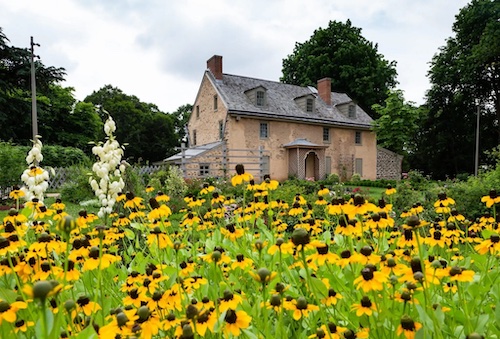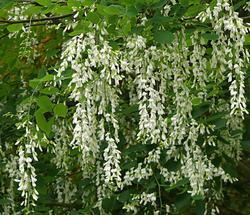A Visit To John Bartram’s Garden
by Lynne Pieri-Finn, Fairfax Master Gardener
 John Bartram is one of Americas first native botanists, and Bartram’s Garden is the first garden featuring native plants. John was born in Pennsylvania in 1699, the son of Quakers. When he was grown, he bought land in Kingsessing, a part of Philadelphia. Bartram’s Garden consists of 14 acres of rolling meadow and woods along the west bank of the Schuylkill River. John Bartram built his own house and his botanic garden on the hillside. An inscription above the second floor window says: John & Ann Bartram 1731. They had ten children.
John Bartram is one of Americas first native botanists, and Bartram’s Garden is the first garden featuring native plants. John was born in Pennsylvania in 1699, the son of Quakers. When he was grown, he bought land in Kingsessing, a part of Philadelphia. Bartram’s Garden consists of 14 acres of rolling meadow and woods along the west bank of the Schuylkill River. John Bartram built his own house and his botanic garden on the hillside. An inscription above the second floor window says: John & Ann Bartram 1731. They had ten children.
John loved to travel to collect plants to bring back to his garden. He traveled up and down the East Coast and as far west as the Mississippi collecting plants. He often traveled with Indians. John had a freed slave, Harvey, who managed the farm when he was away. John kept a lively correspondence with Peter Collinson, a London merchant, also a Quaker, with an interest in the plants. Peter sent John a sundial and compass so that he could navigate his way around the country. They had a correspondence for 30 years. Every autumn, John would send seeds, roots and cuttings in special boxes he built for the long voyage by ship to Peter to be advertised in the Gentlemen’s Magazine, which was sold in Europe. Some even went to King George III who made him the “Kings Botanist,” a title which paid John 50 pounds a year.
Many plants did not survive the journey overseas — they died, rotted or were eaten by insects and rats. Once the plants arrived, however, some of them still had difficulty adapting to a new climate. John sent a cutting of a magnolia tree that took 20 years to flower in England. Somehow Peter and John had a good deal of patience. John’s notes were invaluable, and Peter shared them with notables of the time, such as Carl Linnaeus, a Swedish biologist and physician, who formalized the system of naming species using Latin grammatical forms and Dr. John Fothergill of England who, along with others, used many of John’s plants for medicinal purposes.

Yellowwood blossoms
On my visit to Bartram’s Garden, I could see the skyline of Philadelphia from high on the hill but experienced only calm and quiet. I headed down to the 1.1 mile Bartram’s Mile Trail along the river. I imagined what this site was like 300 years ago when John Bartram lived here. I wandered into Sankofa Community Farm adjacent to the botanical garden. This 3.5 acre crop farm hosts 60 community garden beds, an orchard, a large greenhouse and an education center.
I headed back up towards the Bartram house and passed a tree swing on a huge oak. With no one around, I sat down on the seat, pushed myself back and starting swinging. It was a nice break from the walking. In front of the house, I saw the rustic arbor where John entertained guests like Ben Franklin, George Washington and Thomas Jefferson. And I was amazed at the large stone watering trough John carved himself. I took in the lovely circular garden that was cultivated by John’s granddaughter, Ann Bartram Carr, when she and her husband lived at the house.
I wandered the rest of the property, consisting of many beautiful old trees. I saw a huge squat Yellowwood (Cladrastis kentukea) dated 1790 from Kentucky that was a gift from a French explorer, Andre Michaux. There was a Franklin Tree (Franklinia alatamaha) that John found in Georgia in 1770. He unknowingly saved this fragrant, white-flowered tree from extinction because it has not been found in the wild since then. The Franklin Tree was named after Ben Franklin, of course.

Carolina Silverbell blossoms
I moved off into a series of small gardens cascading down towards the river. There is one called a 1783 Plant Display Catalogue Garden that son William used to produce catalogues. I saw a Carolina Silverbell (Halesia carolina) with its little white flowers hanging down like little bells. I saw two lovely mountain laurels, one pale pink and the other deep pink. Birds were in full song, and the bees very busy racing from shrub to shrub. The understory was full of late blooming snowdrops, wood poppy, wild ginger, creeping jenny and orange columbines with little yellow faces. The sweet violets here could hardly have been called weeds. (John was not a weeder, so he said). I saw beautiful clumps of Canadian white violetsalong with the usual purple. Large red buckeyes (Aesculus pavia) were in bloom with large red panicles of flowers.
During the Revolutionary War, British troops occupied Philadelphia, but Bartram’s land was spared. The City of Philadelphia designated Bartram’s Garden a public park in 1891. John Bartram’s descendants formed an association to assist the city in preserving the garden.
John said “When whoever comes, in care or in glee, shall feel, along with tender beauty everywhere, the strong, still trees about him, and go quieted away.” This is how I felt at John’s garden.
- References
- Bartram’s Garden, 5400 Lindbergh Blvd., Philadelphia, PA
- John and William Bartram, Travelers in Early America, Sandra Wallus Sammons, 2015